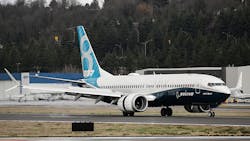Europe Sets Out Demands for Boeing Before Max Can Fly Again
Europe’s aviation regulator has outlined five major requirements it wants Boeing Co. to address before it will allow the planemaker’s 737 Max to return to service, according to a person familiar with the matter.
The European Union Aviation Safety Agency has sent its list to both the U.S. Federal Aviation Administration and Boeing, the individual stated, asking not to be identified because the details aren’t yet public. The FAA hasn’t publicly discussed details about what changes it’s demanding on the Max, so it’s difficult to know whether the EASA demands differ dramatically -- and whether they would significantly boost the cost and time to get the Max back in the air.
The issues being raised by EASA are consistent with the FAA’s own questions, said a person familiar with the U.S. agency’s work who wasn’t authorized to speak about the matter. In a statement, the FAA declined to confirm the specific matters being raised by EASA but said: “The FAA continues to work closely with other validating civil aviation authorities on our review of Boeing’s certification documentation for the 737 MAX. This process involves regular communications among all parties.”
Asked about the potential impact of EASA’s concerns, Boeing issued a statement: “We continue to engage with regulators and are providing information as we work towards the safe return to service for the MAX.”
EASA’s checklist includes the potential difficulty pilots have in turning the jet’s manual trim wheel, the unreliability of the Max’s angle-of-attack sensors, inadequate training procedures, the autopilot failing to disengage in certain emergencies, and a software issue flagged just last week by the FAA pertaining to a lagging microprocessor.
That list excludes several other smaller issues that EASA hasn’t flagged as critical. The agency’s findings follow its broad, independent review of the 737 family’s entire flight control system that focused on the differences between the Max variant and the older “Next Generation” model, the person said. EASA opted to conduct its own assessment of the aircraft.
The review has become a critical focal point for the industry in gauging when the plane will be able to fly again, with regulators globally expected to lean on EASA’s findings. The FAA is facing multiple investigations over its handling of the original certification of the Max and the so-called Maneuvering Characteristics Augmentation System that has been linked to both crashes.
It’s not clear how difficult it will be for Boeing to address the issues described above. People familiar with the matter told Bloomberg last week that the latest software problem could take as long as three months to fix. The FAA has also previously denied that the trim wheel -- which is used to lift or lower a plane’s nose during an emergency -- would cause delays.
Potentially more complex will be addressing the AOA, or angle of attack, sensors on which MCAS relies. At the time of the Ethiopian crash in March, Boeing’s system was using just one of the two sensors installed on the plane. EASA director Patrick Ky said in an interview last month that retrofitting additional hardware was not off the table, a measure that could be costly and time consuming for the manufacturer.
EASA, in its recommendations, stopped short of telling Boeing how to address the issues, instead asking the company to propose solutions that will then be assessed, the person said. For example, if Boeing can prove the effectiveness of a new training procedure that doesn’t include the more burdensome requirement for simulator training, it could avoid that additional expense.
Coordinating Relaunch
Both the FAA and EASA along with Canada and Brazil, have meanwhile come together in tentative agreement that the return to service should be closely coordinated in an effort to help restore public trust in the global aviation safety system, people familiar with the matter have said, though they cautioned that EASA may still make additional requests and lag behind the FAA.
A spokesman for EASA wasn’t immediately able to comment. The FAA said in a statement that it declined to comment on another government agency’s assessment of the 737 Max. FAA acting Administrator Daniel Elwell has said that the grounded plane won’t be returned to service until the agency can be assured it is safe and pilots are adequately trained to handle any emergencies.
Boeing has been telling customers and others in the industry that it expects the plane will be returned to service by September. That timetable includes fixing the software implicated in the two crashes as well as the latest flaw identified with the microprocessor, said a person familiar with the company’s guidance.
By Benjamin Katz and Alan Levin
About the Author
Bloomberg
Licensed content from Bloomberg, copyright 2016.
